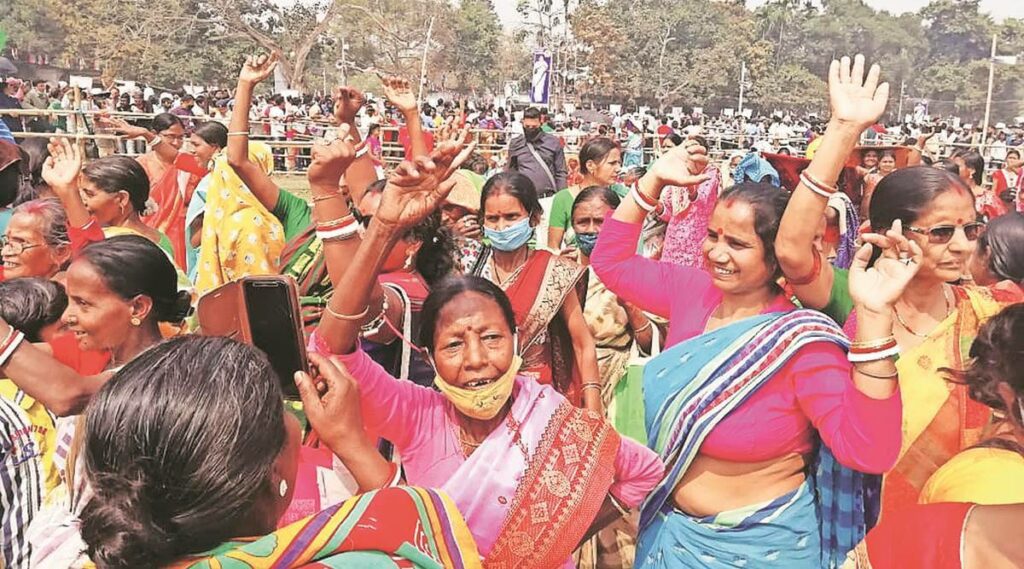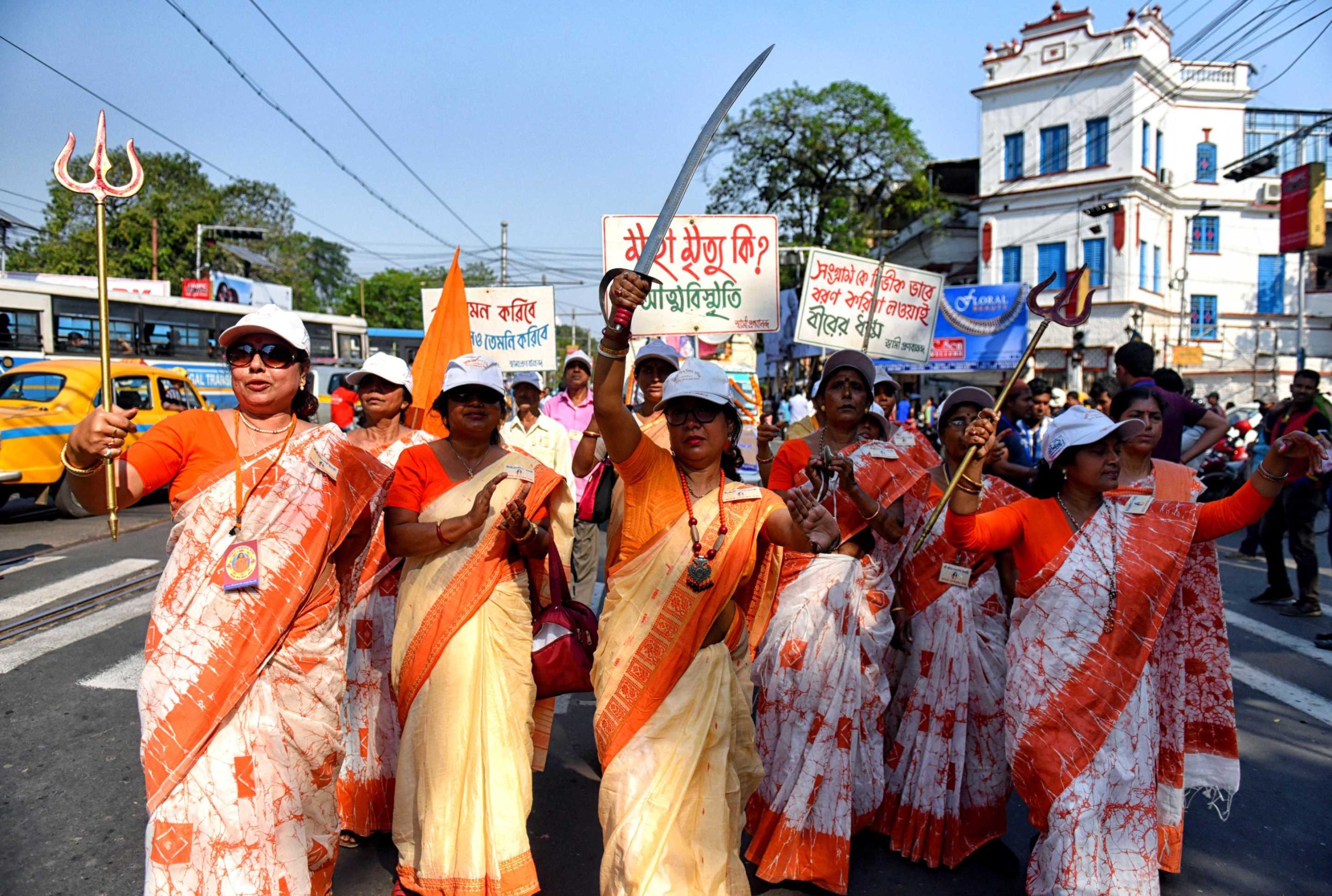With a cast in one leg, sitting on a wheelchair on the rally stage, every time West Bengal Chief Minister Mamata Banerjee concludes her speech, she calls out to the women in the audience and asks, “Amar ma-bonera bolun, khela hobe toh (Tell me my mothers and sisters, is the game on?)” The response that comes from the women in the audience enthusiastically is: “Haan Didi (yes, Didi).”
As the poll progresses in the state of Bengal, women voters have emerged as the rallying point, with both the ruling TMC and the BJP trying to appease them. Over the years, it has become increasingly clear that for any political party to secure victory, the support of the women voters is extremely crucial. Over the last decade, the increasing participation of women in the poll process, emerged as a significant point in the larger politics of the country. The state of West Bengal has faced the same situation, and more so as it is currently the only state to have a 2-time sitting woman chief minister in the country.
Recently when Prime Minister Narendra Modi while referring to Mamata Banerjee during a poll rally in the state, made the ‘Didi o Didi’ jibe, he was called out for his behaviour, which was termed a reflection of the deeply patriarchal mindset of the saffron party, which is trying its best to woo the women voters.
As CM Mamata hops from one rally to another, there is a distinct feature that can be noted in all her rallies. Most of them have a large number of women attendees.
As CM Mamata hops from one rally to another, there is a distinct feature that can be noted in all her rallies. Most of them have a large number of women attendees. It will not be too much of an overreach to say that women attendees in Mamata’s rally in the rural hinterlands like Nandigram, Midnapore, Purulia have been greater than any political rally in the country.

The TMC seems well aware of this trend and their 2021 assembly poll campaign has therefore been centered around the women voters. The party seems to be mindful that understands that just like in Bihar polls, the women vote bank could play a make-or break role in Bengal as well. Mamata Banerjee however has entered the arena much earlier than her opponents and has been cultivating this demographic since she came into power. Be it giving more tickets to women candidates, focusing on women and girls through various state policies and encouraging her party’s women MPs to speak fearlessly, Mamata has dealt all her cards well.
The most talked about among the scheme by the Mamata government has been the ‘Kanyashree’ scheme launched in 2013, which provides cash handouts to girls between 13 and 18 provided they remain unmarried and in school. The larger aim of the scheme is to prevent child marriage and reduce school dropout rate among girls. The scheme also won the United Nations Public Service Award at The Hague in 2017.
The recently launched ‘Swasthya Sathi’, the health insurance scheme, offers a family health card issued in the name of the household matriarch. It must be noted that the schemes implemented by the TMC government in the last decade has had its basis within the women voter base and aims to break the patriarchal mindset of the society by making women the primary focus. The women too have responded positively to these, forming a loyal voter base for the TMC supremo.
According to the Election Commission’s latest electoral rolls for Bengal, the total number of voters in the state are 7.32 crores, among whom 3.73 crore are men, and 3.59 crore, women. One of the biggest reasons for women’s increasing political participation can be attributed to the sharp rise in turnout among rural women voters. Furthermore, there has been an increasing trend of women’s rising participation in the political sphere, which the TMC evidently grabbed with both hands. More and more women voters are now voting according to their wish and not under the influence of any male member of the family.
A large part of Mamata Banerjee’s electoral success in 2011 and 2016 has been attributed to support from the women voters. According to EC data in 2016 assembly polls, 48% women voters supported Mamata Banerjee and Trinamool. Reservation for women in panchayats has expanded from 33% to 50%, the state government claims. TMC is also fielding 50 female candidates this assembly polls, which is its highest ever.
Mamata has also very diligently nurtured the women’s vote bank in the past elections. In the 2019 Lok Sabha polls, TMC was the only party that nominated women in more than 41% of the seats it contested. Seventeen out of its 42 candidates were women, which was higher than the 33% mark. Add to that the fact that Mamata Banerjee is the only woman chief minister in the country, that itself is a lot of heavy lifting.
The party has also played its cards well while dealing with criticism coming its way from the opposition sector. While speaking at public meetings, many TMC leaders attack the BJP as an anti-woman party and highlight crimes against women in BJP-ruled states like Uttar Pradesh. Women’s issues have therefore also been at the centrestage, as direct defense by the TMC against the saffron party.
The BJP has always operated on the principle of Hindutva and the wave of nationalism, where the country is the mother, that needs to be protected. A deeply patriarchal notion, this protector image however has not found its grounds amongst the people of Bengal. Mamata has played up her “daughter of Bengal” identity this time around, projecting the BJP as the “outsiders”.
Using the “us” vs “them” debate that BJP employs in its poll campaigns, TMC has turned it around on them. Add to that the fact that the effect that Mamata, a woman leader of the state has had on the public while speaking about the women, no number of big names from the BJP has been able to topple that. The national leaders including the Prime Minister have rather landed in trouble with the same women voters they went all out to woo, when they have tried to attack Mamata with sexist comments.
While it is true that many are disillusioned by Mamata’s Trinamool Party because of the corrupt nature of its cadre especially in the rural districts of Bengal, most of them still seem to be Mamata’s corner because of the familiarity factor. The Trinamool Congress has adopted the poll slogan ‘Bangla Nijer Meyekei Chay’ (Bengal wants her own daughter), which could be seen as yet another attempt at wooing the women voters by projecting Mamata’s identity as the daughter of the house, which in this context is the state.
The gender identity politics has been played well by the Trinamool Congress, putting their party supremo in the forefront batting against the patriarchal nationalist Hindutva identity politics of the saffron party. And the voters too are seeing Mamata as the lone woman fighting for Bengal’s honour against “outsiders”.
The gender identity politics has been played well by the Trinamool Congress, putting their party supremo in the forefront batting against the patriarchal nationalist Hindutva identity politics of the saffron party. And the voters too are seeing Mamata as the lone woman fighting for Bengal’s honour against “outsiders”.
The opposition BJP too has upped their ante with regards to women voters, mobilising its Mahila Morcha in the state. It has pledged free access to public transport to all women, free education for girls up to post-graduation level and 33% reservation in government jobs for women. Sections of women, particularly the middle class and job aspirants, have seem to have found these promises encouraging. The BJP’s promises has in fact drawn the attention of women in urban and semi-urban areas, even if not so much in rural Bengal.
This brings us to another very important aspect that is playing a major hindrance in Mamata’s poll dreams. It is the class aspect of the women vote bank in Bengal. There’s a stark divide amongst the urban-rural women voters in Bengal. The elite Bengali household finds it difficult to digest the image of the ‘streetfighter’ Mamata. A state that had the longest serving Left government, is still somewhere stuck in that whirlwind of elitism and classism. For the urban women voters, Mamata is someone who does not fit that image, despite being an upper caste savarna leader. They have rather been wooed by the job promises of the BJP. In the rural hinterlands of Bengal however the story is just the opposite. In Nandigram, where the polls took place in a highly polarised environment, there were reports that scores of women voted for Mamata even as the male members of the family voted for the BJP’s Suvendu Adhikari. For them, Mamata is their ‘maatir meye’ (Daughter of the soil).
What we are witnessing in West Bengal, Tamil Nadu, Assam and the other poll states isn’t just business as usual, but a process of that can be called the feminisation of Indian politics. In almost all the states, women electorate outnumbered men electorate. It is therefore quite evident that the focus on women’s issues have finally gathered momentum. Women are now the primary voters. Can Mamata then ride the wave of support from her women vote bank, and the bigger question is can she sustain it? That is left to be seen once the results are in.
Featured image source: India Today
About the author(s)
Shriya is a former student of literature and a multimedia journalist with an interest in sports and human rights. She can be found watching Shah Rukh Khan movies or listening to Ali Sethi and 90s Bollywood songs. She enjoys a good cup of black coffee multiple times a day and is often compared to 'Casper, the friendly ghost'.




